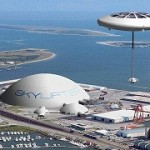Skylifter Looks Like a Flying ‘Skittle’
Posted on October 3, 2010
Filed Under Business, Technology | Leave a Comment
The other day, just up the rural road from where we live, a truck with an oversized load – maybe the cylinder of a farmer’s new silo – was announced by the flashing lights of its escort truck. It was touch-and-go as the truck and its load turned the tight corner. We pictured the convoy in all the antsy scrapes it would be in that day and wondered, mightn’t there a better way to transport oversized loads that are too heavy for helicopters?
 From Australia comes a hopeful “Yes!” The Aussie aeronautical company Skylifter has come up with a variation of a balloon – an inflatable flying saucer – that in three years or so it expects to be flying heavy equipment, even whole buildings, to remote areas. Heavy transport helicopters can lift “only” 20 tons. The Skylifter is envisioned to haul as much as 150 tons, a 700 percent increase, reports Popular Science. With its thinner profile, the “saucer” should be less susceptible to winds during flight. It’s expected to have a range of 1240 miles. The control pod, or aerostat, hangs below the “saucer” on what seems like a pole and has propellers for steering the aircraft. All-in-all from a distance, the Skylifter will probably look something like a child’s skittles top.
From Australia comes a hopeful “Yes!” The Aussie aeronautical company Skylifter has come up with a variation of a balloon – an inflatable flying saucer – that in three years or so it expects to be flying heavy equipment, even whole buildings, to remote areas. Heavy transport helicopters can lift “only” 20 tons. The Skylifter is envisioned to haul as much as 150 tons, a 700 percent increase, reports Popular Science. With its thinner profile, the “saucer” should be less susceptible to winds during flight. It’s expected to have a range of 1240 miles. The control pod, or aerostat, hangs below the “saucer” on what seems like a pole and has propellers for steering the aircraft. All-in-all from a distance, the Skylifter will probably look something like a child’s skittles top.
 From the gallery of photos that Skylifter provides, the Skylifter looks like it could be transporting welcome loads to exotic places, even a whole “hotel.” The Skylifter has obvious implications for nuclear power plant construction or refurbishment. Imagine not having to haul, say, new steam generators across the countryside.
From the gallery of photos that Skylifter provides, the Skylifter looks like it could be transporting welcome loads to exotic places, even a whole “hotel.” The Skylifter has obvious implications for nuclear power plant construction or refurbishment. Imagine not having to haul, say, new steam generators across the countryside.
Dirigibles have been another much-anticipated flying freight solution, so the Skylifter may have competition for lighter-than-air heavy lifting. – Doug Bedell
Ford Debuts An Electric Focus
Posted on September 16, 2010
Filed Under Business, Technology | Leave a Comment
This isn’t an electric car blog, but we’ve been following developments toward diversified transportation because we truly need to shake up our transportation system. Today Ford announced an electric Focus, a car with special appeal to us, because we own a gasoline-powered model and love it.
 The thing is, though, Ford announced the car in partnership with the Texas utility, Oncor. And that immediately illustrated a limitation of all-electric vehicles. Iris Kuo, the GreenBeat reviewer, reached to turn on the air conditioning and Ford’s representative in the car asked her to turn it back off. Reason: the A/C drains the battery too much. But they couldn’t figure out how to shut it off “thanks to a confusing control panel.”
The thing is, though, Ford announced the car in partnership with the Texas utility, Oncor. And that immediately illustrated a limitation of all-electric vehicles. Iris Kuo, the GreenBeat reviewer, reached to turn on the air conditioning and Ford’s representative in the car asked her to turn it back off. Reason: the A/C drains the battery too much. But they couldn’t figure out how to shut it off “thanks to a confusing control panel.”
So there goes the Texas market, where temperatures are high and distances long. Ah well, it’s no doubt a lovely car for other, more temperate locales. (It should be available next year.)
Oncor has installed 1.2 million smart meters, which will help consumers decide when rates are lowest for charging electric vehicles. Texas at least has lots of energy reserves.
Buyers of the first all-electric cars are going to be a little like modern-day pioneers, figuring out what the best blend of charging and mileage might be. Sort of like how far horses could pull before they got too hungry and fatigued. There’s also a need to educate emergency responders about electrics, who could be endangered by the high battery voltage at the scene of an accident.
But this is important stuff, because our transportation system truly needs a broader mix of motive power. – Doug Bedell
900,000-For-All In Chinese Factory ‘Cities’
Posted on September 13, 2010
Filed Under Business, Technology | Leave a Comment
We’re feeling a little differently about using our iPhone and other electronic gadgets after reading the Bloomberg Businessweek profile of the Foxconn Corp. in China, which operates from city-sized factory campuses and has had to give special attention to preventing suicides among its 920,000-plus employees in mainland China.
Not that Foxconn’s working conditions, apparently, are all that dire. They’re not necessarily crushing, just concentrated, apparently with middle managers who aren’t sufficiently trained or adept at dealing with employees en masse.
 Terry Gou, Foxconn’s hard-charging founder and chairman, has been eating three meals a day at work and not getting a lot of sleep figuring how to keep the huge company growing while being more considerate of its employees at the same time. American firms like IBM, Cisco, Microsoft, Hewlett-Packard, Apple and Dell are wishing him well, for they are among Foxconn’s high-tech customers.
Terry Gou, Foxconn’s hard-charging founder and chairman, has been eating three meals a day at work and not getting a lot of sleep figuring how to keep the huge company growing while being more considerate of its employees at the same time. American firms like IBM, Cisco, Microsoft, Hewlett-Packard, Apple and Dell are wishing him well, for they are among Foxconn’s high-tech customers.
Gadgets come at a price, and the price is more than the figures on a sales slip. Consumers need to recognize that. Foxconn can concentrate efficiencies to produce electronic innards at highly advantageous prices, but consumers around the world should be rooting for it to become increasingly proficient at insuring the welfare of its armies of employees.
Chairman Gou seems to understand that installing suicide-prevention nets on Foxconn dormitories isn’t really the answer, though the nets were installed last May, Bloomberg Businessweek reports, after the ninth Foxconn worker jumped to his death this year, .
The pressures of obtaining enough raw materials and maximizing production in the face of brisk consumer demand – think of how effectively Steve Jobs revs up interest in Apple’s latest products, for instance – possibly haven’t allowed comparable attention to workplace issues. But Terry Gou seems intent on catching up there. Foxconn has launched a “Prevention-Reengineering Caring” program including “24-hour care centers staffed by certified counselors…and is teaching managers to be more attuned to workers’ emotional needs.”
“‘Yelling is not the only way,’ says Louis Woo, a 62-year-old Stanford graduate, whom Foxconn “picked to brief Bloomberg Businessweek on the company’s transformation into a more benign corporate citizen.”
Indeed not. Companies who sell tools for better, more efficient lives for consumers need to apply that same ingenuity to managing their workers well, as challenging an obligation as that may be. – Doug Bedell
Letdowns From Inventive Heights
Posted on September 1, 2010
Filed Under Business, Technology | Leave a Comment
Inventors often feel they are in the service of a higher goal than cleverness, but sometimes ingenuity has to be based on more than good intentions. This thought occured to us on reading in The New Yorker, as the anniversary of 9/11 approaches, of the Rescue Reel. This is a well-meaning device, created at a cost of $335,000 in the inventor’s personal savings, for letting people down from skyscrapers when it’s not possible to take an elevator or even the stairs.
Unless the $1,500 purchase price can be reduced considerably, or building codes in major cities become further sources of inflation, the Rescue Reel would seem to have limited potential, despite its cleverness. Its inventor, Kevin R. Stone, a California orthopedic surgeon, visited The New Yorker’s offices recently to describe how the device works, after explaining that he was deeply moved by the fate of the people trapped on the upper floors of the World Trade Center. So much so that he proceeded to develop the Rescue Reel on the model of a fishing reel.
“I remember thinking right then (on 9/11), If I can reel in a four-hunded pound fish, why can’t I reel out a four-hundred pound person?” Well, most of the panicked people would weigh less than that, a factor in favor of relieving stress on the mechanism, at least.
 We get stressed thinking that a skyscraper descent system – down the exterior of a glass-walled tower – might even be needed again. Possibly so, but heaven help us if that’s the case. What needs to be learned from 9/11 is how to provide security against an attack on an office tower, and the Transportation Security Administration (TSA) has been doing a pretty good job of that at the nation’s airports. Also, we’re fighting a war to dissuade any further aerial terrorism. Maybe that won’t do it, but how many people can you picture letting themselves down the outside of a burning, smoke-belching skyscraper? Or even one in which the elevators are merely stuck, and you don’t feel like walking down all those stairs?
We get stressed thinking that a skyscraper descent system – down the exterior of a glass-walled tower – might even be needed again. Possibly so, but heaven help us if that’s the case. What needs to be learned from 9/11 is how to provide security against an attack on an office tower, and the Transportation Security Administration (TSA) has been doing a pretty good job of that at the nation’s airports. Also, we’re fighting a war to dissuade any further aerial terrorism. Maybe that won’t do it, but how many people can you picture letting themselves down the outside of a burning, smoke-belching skyscraper? Or even one in which the elevators are merely stuck, and you don’t feel like walking down all those stairs?
As The New Yorker puts it: “Providing a Rescue Reel for every office worker and apartment dweller above the reach of a Fire Department ladder would cost billions, yet no more than a tiny number of the devices, presumably, would ever be used; in terms of the greatest likely benefit to the largest number of people, mightn’t a sounder investment be colonoscopies?”
We’re not looking to deter inventiveness in writing this, and we note that Dr. Stone feels the price of Rescue Reels will come down considerably when/if they go into mass production. But all kinds of questions arise if you picture a smoke-filled corridor with dozens of panicked people, and a limited number of Rescue Reels on hand to save some of them. Better that we apply all possible ingenuity to attempting to insure that the ghastly sort of no-exit situation created on 9/11 doesn’t occur again.
Use Rescue Reels, we’d suggest, for making rappelling safer for rock climbers. Though there, it’s the sport that matters, not the assurance of a safe descent. Foreseeable utility needs to accompany inspiration, doesn’t it? – Doug Bedell
Memory’s a Dance, Says Dr. Day
Posted on July 30, 2010
Filed Under Business, Technology, The Writing Life | Leave a Comment
Permit us to introduce you to Ruth S. Day, a cognitive scientist at Duke University. Why? Because Dr. Day is doing intensive study of memory, and memory is large where everything begins, in technical writing as well as other fields, not to mention life itself.
 Dr. Day has been studying how professional dancers remember their routines. Have you ever thought about that? A modern dance company doesn’t have classical terms for movements, like ballet companies do. So some, like Pilobolus, make up names for the shapes they get their dancer’s bodies into – like “shooting seagulls” or “fat gnomes.” Others, like The Merce Cunningham company, feel that labeling dance moves with words is limiting.
Dr. Day has been studying how professional dancers remember their routines. Have you ever thought about that? A modern dance company doesn’t have classical terms for movements, like ballet companies do. So some, like Pilobolus, make up names for the shapes they get their dancer’s bodies into – like “shooting seagulls” or “fat gnomes.” Others, like The Merce Cunningham company, feel that labeling dance moves with words is limiting.
Memory itself is sort of a dance of associations. Pick your own associations.
“There’s no right or wrong strategy,” Day says, “but certain strategies work better in certain situations and the more memory tools a dancer has, the better. The end goal is not memory in and of itself, but to get past the learning and worrying about it – to do the movement well and enjoy it.”
It all seems to come down to identification and intentionality – identifying what you want to accomplish via a technique or gimmick – anything that works for you – and being intentional about that process.
We’re trying, for instance, to improve our quick recognition of jazz piano passages. And we’re finding that looking at the notes as parts of chords is helpful – that’s a structural approach, rather than a strictly visual one. But what the heck, since it seems to have potential, we’ll try to develop it.
“Whatever works for you,” seems to be a decent memory slogan. The need is to get serious about remembering, and pick your own cues.
Dr. Day has more insights into this subject – What subject was that ? Oh yes, memory – at physorg.com and some further encouragement. We’re glad we’ve met her via the web, and suspect you will be as well. – Doug Bedell
On Garages as Inspiring Places…
Posted on July 24, 2010
Filed Under Business, Technology | Leave a Comment
 We had occasion to note the entrepreneurial importance of garages as start-up locales in our last Insights post on Andy Grove’s concerns about the status of U.S. manufacturing. One such garage – where Bill Hewlett and Dave Packard got started 70 years ago was designated a national historic landmark in 2007.
We had occasion to note the entrepreneurial importance of garages as start-up locales in our last Insights post on Andy Grove’s concerns about the status of U.S. manufacturing. One such garage – where Bill Hewlett and Dave Packard got started 70 years ago was designated a national historic landmark in 2007.
As we happened upon that bit of Internet information, we wondered about the garage where Steve Jobs and Steve Wozniak developed the first Apple computer almost 35 years ago.  We haven’t been readily able to determine its present status, but that garage was part of Jobs’ parents’ home on Crist Drive in Los Altos, CA. (The two Steves actually began creating their revolutionary computer in a spare bedroom, then moved production to the garage.)
We haven’t been readily able to determine its present status, but that garage was part of Jobs’ parents’ home on Crist Drive in Los Altos, CA. (The two Steves actually began creating their revolutionary computer in a spare bedroom, then moved production to the garage.)
Both these garages, of course, are part of the high-tech Silicon Valley story and we normally don’t cover computer technology, because lots of other blogs do. But garages initially aren’t mystical places. They’re handy, available, low-budget spaces with a roof and probably electricity. They only become famous when the ingenuity employed in them proves to be truly visionary.
Even so, we thought you’d enjoy seeing two of the nation’s most famous garages. If your kids want a place to indulge some of their ideas, make yours available. It may become a laboratory setting, a convenient outlet for creativity and, with luck, a source of great wealth. – DB
Andy Grove ‘Gets Real’ About Manufacturing
Posted on July 18, 2010
Filed Under Business | 1 Comment
What about the continuing drain in American manufacturing jobs? What do we do about it? Why do anything, you say? We still have knowledge creation occurring in the U.S. and that’s what counts.
Well think about it. Andrew “Andy” Grove, co-founder and now a senior adviser to Intel, prompts such salutary thinking in an article – “How to Make an American Job” – in the July 5-11 Bloomberg Businessweek. (We get Bloomberg Businessweek, but we happened upon the Grove article first in surfing the web for technology stories and hitting on the MetalMiner blog. Which demonstrates the unpredictable currents bringing information to our eyeballs these days.)
 If we cheer aspiring entrepreneurs operating from garages and other start-up locales, but then send the scale-up and production capacity to China or elsewhere (as we’ve been doing), “What kind of a society are we going to have if it consists of highly paid people doing high-value-added work and masses of unemployed?” A really good and timely question.
If we cheer aspiring entrepreneurs operating from garages and other start-up locales, but then send the scale-up and production capacity to China or elsewhere (as we’ve been doing), “What kind of a society are we going to have if it consists of highly paid people doing high-value-added work and masses of unemployed?” A really good and timely question.
China’s Hon Hai Precision Industry Co. (also known as Foxconn) now employs more than 800,000 people, more, Grove notes, “than the combined worldwide head count of Apple, Dell, Microsft, Hewlett-Packard Co., Intel and Sony Corp.”
Back in 1980, 10 years after it was capitalized for production, Intel had about 13,000 people making computer chips in the U.S. And a host of other companies were sprouting up, and employing Americans, in the Silicon Valley around Intel. But “as time passed,” Grove recalls, “wages and health-care costs rose in the U.S., and China opened up. American companies discovered they could have their manufacturing and even their engineering done cheaper overseas.” So, increasingly, they did. “Today,” Grove points out, “manufacturing employment in the U.S. computer industry is about 166,000 – lower than it was before the first personal computer, the MITS Altair 2800, was assembled in 1975. Meanwhile, a very effective computer -manufacturing industry has emerged in Asia, employing about 1.5 million workers – factory employees, engineers and managers.”
And that’s not just happening in computers. We’ve been writing on Insights about electric cars. Well, their lithium-ion batteries are being made overseas. Not only that, those batteries were developed overseas. When, 30 years ago, the U.S. quit making consumer electronics devices, Grove advises, we lost our lead in batteries too. The scaling took place overseas and now it’s doubtful that U.S. companies “will ever catch up” in battery technology.
When you let something like batteries or photovoltaic panels get away from you, you can lose whole job-creating manufacturing industries. Those guys in the next garages over may never be bright enough to catch up with that.
Bright people need to start thinking keenly about others, our own kids and aspiring workers. Where are they going to be employed a couple of decades from now? It’s a worrisome outlook indeed.
Grove says we need “a job-centric economic theory – and job-centric political leadership to guide our plans and actions. We need specific actions, as well, like financial incentives “to rebuild our industrial commons.” Grove, who grew up in Soviet-dominated Hungary and fled to the U.S. for its opportunities, suggests an “extra tax on the product of offshored labor. (If the result is a trade war, treat it like other wars – fight to win.)”
Yes, you probably sensed where this was heading – we’ve got to start thinking differently about concepts like fair and free trade and where they’ve been taking the economic prospects of growing numbers of Americans. We don’t like “war” metaphors, we don’t want to get nasty, just considerate of what it may take to have people thrive, as they once did, on production lines in the U.S., as well, now, as around the world. – Doug Bedell
Doing Anything Creative Today?
Posted on July 14, 2010
Filed Under Business, Technology | Leave a Comment
Newsweek has done the U.S. a service by devoting its July 19 cover to “Creativity in America,” a lengthy article sparked by the discovery that creativity in America is declining. By whose measure comes that ominous news?
 Well, there are IQ tests and there’s a creativity test – the Torrance test (named after the late Prof. E. Paul Torrance), which has been around for 50 years. While IQ scores have been steadily rising, since 1990 Torrance scores have been steadily declining.
Well, there are IQ tests and there’s a creativity test – the Torrance test (named after the late Prof. E. Paul Torrance), which has been around for 50 years. While IQ scores have been steadily rising, since 1990 Torrance scores have been steadily declining.
Newsweek reports that Kyung Hee Kim at the College of William & Mary discovered the creativity decline just this May in analyzing almost 300,000 Torrance scores of children and adults. “It’s very clear, and the decrease is very significant,” Kim says, adding that the decline is “most serious” among younger children, from kindergarten through sixth grade.
As Newsweek notes, such a decline could have dire consequences as the kids age. The situation should cause each of us to think about how creatively we’ve been living, and what we might do to boost our flashes of insight and brilliance.
This can be truly serious. Factors from excessive TV watching to neglecting to encourage creativity in schools are cited. “In China,” by contrast, advises Newsweek, “there has been widespread education reform to extinguish the drill-and-kill teaching style. Instead, Chinese schools are also adopting a problem-based learning approach.”
Jonathan Plucker, of Indiana University, was amazed in touring schools in Shanghai and Beijing to find a boy “who, for a class project, rigged a tracking device from his moped with parts from a cell phone.”
When the faculty of a Chinese university asked Plucker to identify trends in American educatiion, “he described our focus on standardized curriculum, rote memorization, and nationalized testing. ‘After my answer was translated, they just started laughing out loud,’ Plucker says. ”They said, ‘You’re racing toward our old model. But we’re racing toward your (fancied) model, as fast as we can.”
“Your model,” to the extent it exists in American schools currently, is a project- and research-oriented one that can be included in existing curriculums if educators and school boards recognize that it needs to be. We all need to get serious about improving our creativity, now and for the long term.
We can start by simply logging how many good ideas we’ve had recently, and encouraging more of them to dawn by reading and looking around at what needs to be accomplished in the interest of ourselves and others. Thanks Newsweek! – Doug Bedell
No Excuses, At Least Not These
Posted on July 6, 2010
Filed Under Business | Leave a Comment
Engineering is pressurized work and not everything gets accomplished on time or according to schedule. When delays occur, it’s important to be clear about why they did and to learn from them.
 That necessary purpose can be obscured by defensive responses to missed deadlines. “Don’t use excuses, supply reasons,” is our capsulized guidance culled from a list of “10 excuses your boss doesn’t want to hear,” provided by Justin James on the TechRepublic blog. We would only add that bosses, too, need to be sensitive to what may have actually happened – to be willing to learn.
That necessary purpose can be obscured by defensive responses to missed deadlines. “Don’t use excuses, supply reasons,” is our capsulized guidance culled from a list of “10 excuses your boss doesn’t want to hear,” provided by Justin James on the TechRepublic blog. We would only add that bosses, too, need to be sensitive to what may have actually happened – to be willing to learn.
Here’s Justin’s list. We’re capsulizing his explanations; he spells each of them out. Most come down to – pay heed first off:
1. I didn’t understand the assignment – Things should be fully understood at the start. If a boss doesn’t have the greatest communication skills, more attentiveness to clarifying the project is required.
2. The deadline was impossible – Don’t accept a ridiculous deadline. Talk it through with your boss beforehand.
3. A valuable resource wasn’t available – If something is missing, that needs to be known at the start.
4. The requirements shifted – As new requirements come up, be mindful of them and their possible impact on the project. Make changes in deadlines as advisable.
5. I have personal issues – Who doesn’t? Get help with them as necessary.
6. I don’t have enough time – Manage your plate well, and surface time issues promptly.
7. I don’t know what went wrong – Well, gee…
8. We ran into blockages – Sort them out promptly and effectively.
9. The only copy of the work got destroyed – Make backups hither and yon.
10. The dog ate my homework – Inexplicable events happen. Roll with them.
– Doug Bedell
Nuclear’s Preparedness Lessons
Posted on June 29, 2010
Filed Under Business, Technology | Leave a Comment
 Like all of you, I’ve been watching with increasing dismay the gulf oil fiasco. Amid the scenes of gushing crude, oil-soaked birds, and iridescent marshes it is easy to forget that good and competent people are working around the clock trying to stop the oil. At some point they will succeed and we can get on with Phase 2: Endless litigation and interminable government hearings. Will any good come from all the Sturm und Drang? If the last such accident of national consequence is any indication, perhaps the answer is yes.
Like all of you, I’ve been watching with increasing dismay the gulf oil fiasco. Amid the scenes of gushing crude, oil-soaked birds, and iridescent marshes it is easy to forget that good and competent people are working around the clock trying to stop the oil. At some point they will succeed and we can get on with Phase 2: Endless litigation and interminable government hearings. Will any good come from all the Sturm und Drang? If the last such accident of national consequence is any indication, perhaps the answer is yes.
After Three Mile Island (TMI) the U.S. nuclear power industry went through all the Kubler-Ross stages:
• Denial: This appears to be much ado about nothing.
• Anger: Dammit… who screwed up, whose fault is this?
• Bargaining: Whoa, slow down with all the proposed regulations…let’s just reason together.
• Depression: This industry is dead; there’s no way we can afford all these new rules and retrofits.
• Acceptance: We’re still America’s best energy hope; we’re going to come back stronger than ever.
 After TMI the nuclear industry did some soul-searching and decided: One more event like this and we are doomed as an industry, so let’s make sure it doesn’t happen again. And many of the innovations that followed TMI have contributed to the industry’s excellent performance and budding renaissance. These include:
After TMI the nuclear industry did some soul-searching and decided: One more event like this and we are doomed as an industry, so let’s make sure it doesn’t happen again. And many of the innovations that followed TMI have contributed to the industry’s excellent performance and budding renaissance. These include:
• Creating the Institute of Nuclear Power Operations to set benchmarks, identify and exchange power plant best practices, and generally pursue operational excellence.
• Creating the World Association of Nuclear Operators to do more or less the same thing across national borders
• Funding ambitious government research projects that investigated exactly how nuclear accidents initiate and progress, including a major initiative on the human factors component
• Conducting large-scale experiments to duplicate the TMI events and learn exactly what happened, down to very subtle chemical effects occurring inside the nuclear fuel
• Nuclear utility competitors pooling their resources to sponsor their own accident prevention research
• New accident detection and prevention technologies mandated for new plants and retrofit into existing plants
Looking at this list, I see a path – after this oil well is capped and the cleanup is behind us – towards a much safer and better run offshore oil industry. Oil will be in our future for all of our lifetimes. Let’s make sure we do it right.
And oh by the way nuclear industry, it’s been 30+ years since TMI. Are you still looking over your shoulder and remembering your 1979 lesson of eternal vigilance? – Dennis Owen
Recently
- Presentations With Forethought
- Technical Writing’s Lineage – Surely It’s Deeper than Digital
- At the Holidays, Twitting Amazon
- Successful Cookie Baking – From Mom, an Acknowledged Expert
- Slides for a Tech Writer’s Craft
- Digital or Not, Be Clear
- Being Watchful About Digital Designs…
- When Proposals Don’t Click, Keep Making Them Anyway
- Like a Good Gardener, Help an Enterprise Keep Itself Current
- We’re Leaders All, And Need to Think That Way
Categories
Archives
- January 2017
- December 2016
- November 2016
- October 2016
- September 2016
- August 2016
- July 2016
- June 2016
- May 2016
- April 2016
- March 2016
- February 2016
- January 2016
- December 2015
- November 2015
- October 2015
- September 2015
- August 2015
- July 2015
- June 2015
- May 2015
- April 2015
- March 2015
- February 2015
- January 2015
- December 2014
- November 2014
- October 2014
- March 2014
- February 2014
- January 2014
- December 2013
- November 2013
- October 2013
- September 2013
- August 2013
- July 2013
- June 2013
- May 2013
- April 2013
- March 2013
- February 2013
- January 2013
- December 2012
- November 2012
- October 2012
- September 2012
- August 2012
- July 2012
- June 2012
- May 2012
- April 2012
- March 2012
- February 2012
- January 2012
- December 2011
- November 2011
- October 2011
- September 2011
- August 2011
- July 2011
- June 2011
- May 2011
- April 2011
- March 2011
- February 2011
- January 2011
- December 2010
- November 2010
- October 2010
- September 2010
- August 2010
- July 2010
- June 2010
- May 2010
- April 2010
- March 2010
- February 2010
- January 2010